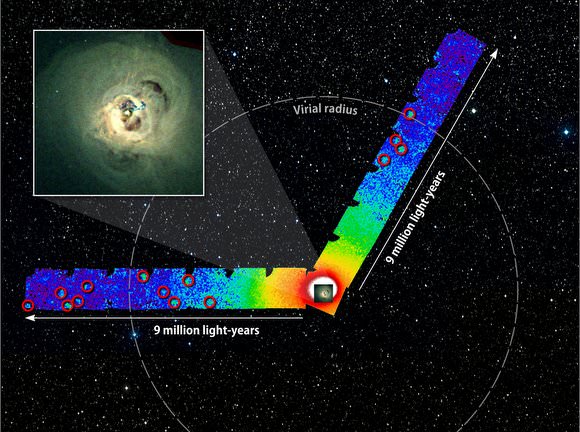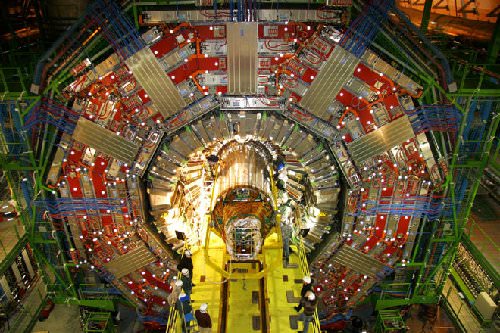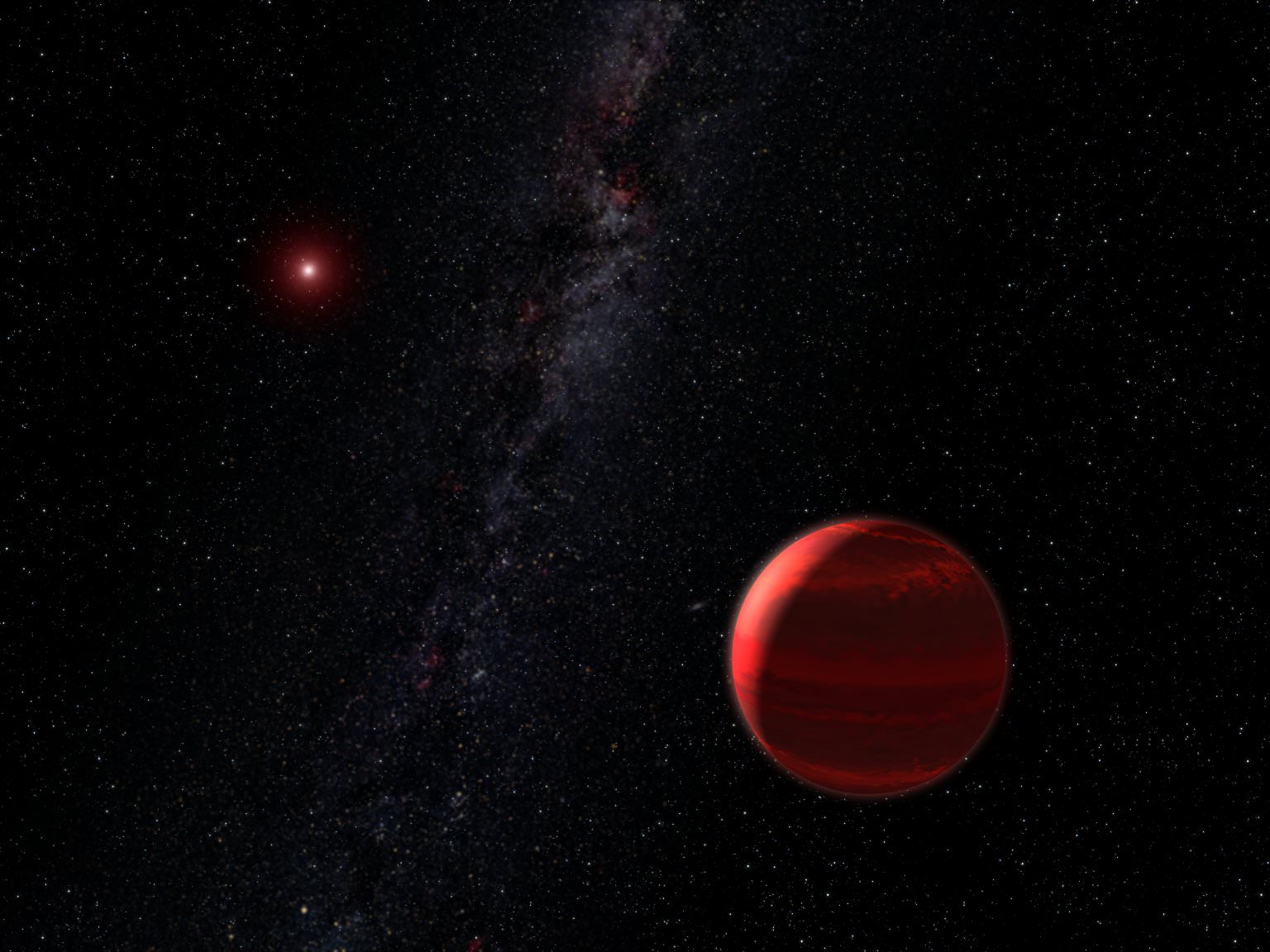In this video Saul Perlmutter, one of the three winners of the 2011 Nobel Prize in Physics, explains how dark energy, which makes up 70 percent of the universe, is causing our universe to expand.
Milky Way Arm Wrestles With Dark Matter
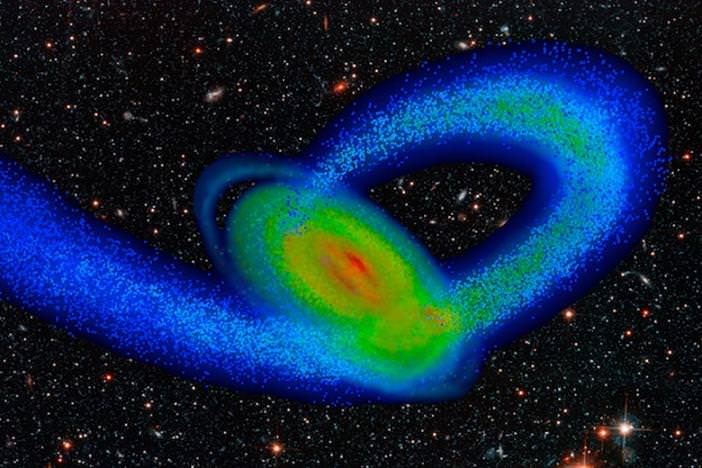
[/caption]
For a good number of years, astronomers have hypothesized the Sagittarius Dwarf Galaxy has been loaded up with dark matter. As one of our nearest neighboring galaxies and part of our local group, Sag DEG has been hanging around for billions of years and may have orbited us as many as ten times. However, in order to survive the tidal strain of such interaction, this loop-shaped elliptical has got to have some muscle. Now UC Irvine astronomers are speculating on how these close encounters may have shaped the Milky Way’s spiral arms.
In a study released in today’s Nature publication, astronomers are citing telescopic data and computer modeling to show how our local galactic collision has sent streams of stars out in loops in both galaxies. These long streamers continue to collect stellar members and the rotation of the Milky Way forms them into our classic spiral pattern. The news is the presence of dark matter in Sag DEG is responsible for the initial push.
“It’s kind of like putting a fist into a bathtub of water as opposed to your little finger,” said James Bullock, a theoretical cosmologist who studies galaxy formation.
But the little Sagittarius Dwarf, as strong as the dark matter might be, isn’t going to win this cosmic arm wrestling match. Each time we interact, the small galaxy gets further torn apart and about all that’s left is four globular clusters and a smattering of old stars which spans roughly 10,000 light-years in diameter.
“When all that dark matter first smacked into the Milky Way, 80 percent to 90 percent of it was stripped off,” explained lead author Chris Purcell, who did the work with Bullock at UCI and is now at the University of Pittsburgh. “That first impact triggered instabilities that were amplified, and quickly formed spiral arms and associated ring-like structures in the outskirts of our galaxy.”
Will we meet again? Yes. The Sagittarius galaxy is due to strike the southern face of the Milky Way disk fairly soon, Purcell said – in another 10 million years or so.
Original Story Source: University of Irvine News. Further Reading: The Sagittarius impact as an architect of spirality and outer rings in the Milky Way.
Alone In The Dark?
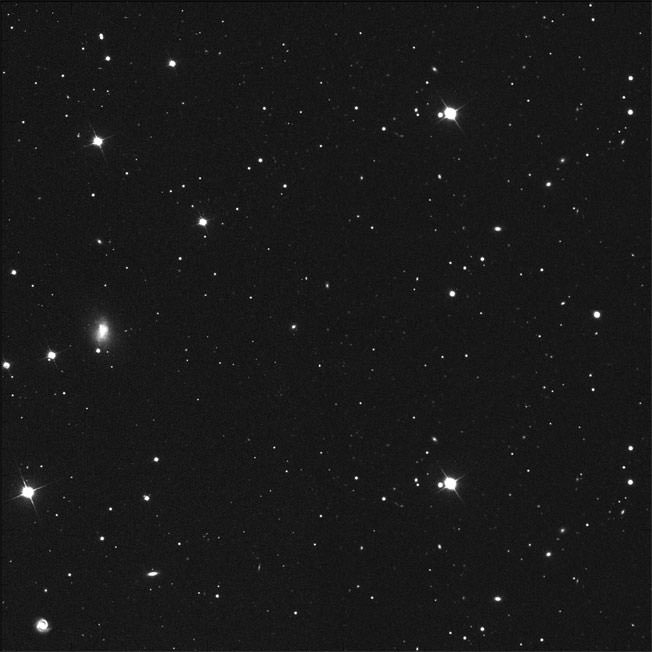
[/caption]
Two years ago, Marla Geha, a Yale University astronomer, Joshua Simon from the Carnegie Institution of Washington, and their colleagues discovered something unusual while studying with the Keck II telescope and information for the Sloan Digital Sky Survey. Their observations turned up a contrasting group of stars which all appeared to be moving in unison – not just a moving cluster of similar stars which could have been torn away from the nearby Sagittarius dwarf galaxy. The team knew they were on to something, but a competing group of astronomers at Cambridge University was skeptical. Too bad… there was a dark treasure right there before their eyes.
Not to be dissuaded, Simon, Geha and their group returned to Keck and turned the photographic eye of the telescope’s Deep Extragalactic Imaging Multi-Object Spectrograph (DEIMOS) towards their target area. Even though it was only about 1,000 small, dim stars, they wanted to know how they migrated both in respect to the Milky Way and to each other. Named Segue 1, the target the team was looking at could possibly have 3,400 times more mass than can be accounted for by its visible stars… a galaxy dominated by dark matter and salted with a handful of ancient suns. If the 1,000 or so stars were all there was to Segue 1, with just a touch of dark matter, the stars would all move at about the same speed, said Simon. But the Keck data show they do not. Instead of moving at a steady 209 km/sec relative to the Milky Way, some of the Segue 1 stars are moving at rates as slow as 194 kilometers per second while others are going as fast as 224 kilometers per second.
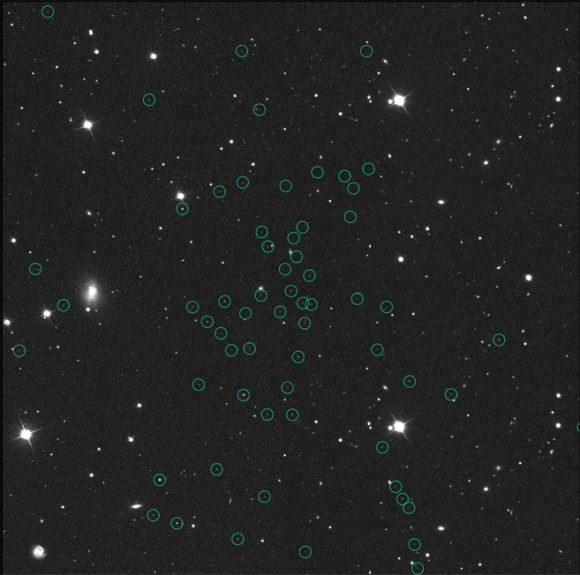
“That tells you Segue 1 must have much more mass to accelerate the stars to those velocities,” Geha explained. The paper confirming Segue 1’s dark nature appeared in the May 2011 issue of The Astrophysical Journal. “The mass required to cause the different star velocities seen in Segue 1 has been calculated at 600,000 solar masses. But there are only about 1,000 stars in Segue 1, and they are all close to the mass of our Sun,” Simon said. “Virtually all of the remainder of the mass must be dark matter.”
But the information from DEIMOS didn’t stop there… It also revealed an eclectic collection of nearly primordial metal-poor stars. The researchers managed to gather iron data on six stars in Segue 1 with the Keck II telescope, and a seventh Segue 1 star was measured by an Australian team using the Very Large Telescope. Of those seven, three proved to have less than one 2,500th as much iron as the Sun. “That suggests these are some of the oldest and least evolved stars that are known,” said Simon. This is fascinating data considering investigations for stars of this type out of the Milky Way’s billions have produced less than 30. “In Segue 1 we already have 10 percent of the total in the Milky Way,” Geha said. “For studying these most primitive stars, dwarf galaxies are going to be very important.”
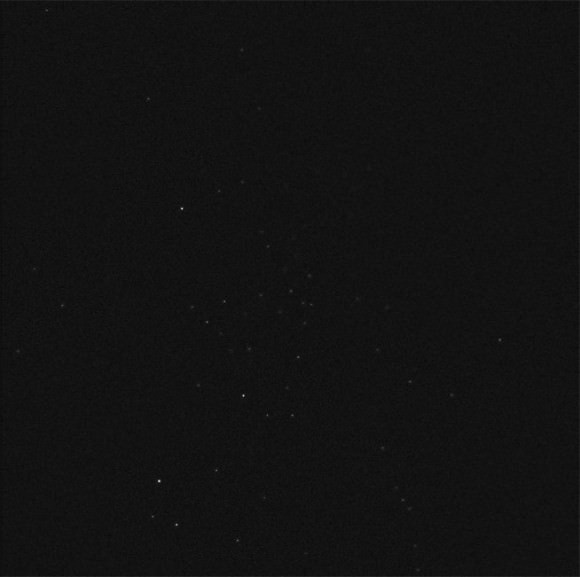
By confirming Segue 1’s massive concentration of dark matter, other types of research into this dark galaxy’s lifestyle now become more dedicated. The space-based Fermi Gamma Ray Telescope has also been looking its way in hopes of catching a gamma-ray event created by the collision and annihilation of pairs of dark matter particles. So far the Fermi telescope has not detected anything of the sort, which isn’t entirely surprising and doesn’t mean the dark matter isn’t there, said Simon.
“The current predictions are that the Fermi telescope is just barely strong enough or perhaps not quite strong enough to see these gamma rays from Segue 1,” Simon explained. So there are hopes that Fermi will detect at least the hint of a collision. “A detection would be spectacular,” said Simon. “People have been trying to learn about dark matter for 35 years and not made much progress. Even a faint glow of the predicted gamma rays would be a powerful confirmation of theoretical predictions about the nature of dark matter.”
Let’s hope Segue 1 isn’t alone in the dark.
Original News Source: Keck Observatory Science News.
A Four Cluster Pile-Up
[/caption]
Abell 2744, shown above in a composite of images from the Hubble Space Telescope, the ESO’s Very Large Telescope and NASA’s Chandra X-ray Observatory, is one of the most complex and dramatic collisions ever seen between galaxy clusters.
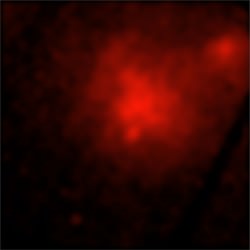
Dubbed “Pandora’s Cluster”, this is a region 5.9 million light-years across located 3.5 billion light-years away. Many different kinds of structures are found here, shown in the image as different colors. Data from Chandra are colored red, showing gas with temperatures in the millions of degrees. Dark matter is shown in blue based on data from Hubble, the European Southern Observatory’s VLT array and Japan’s Subaru telescope. Finally the optical images showing the individual galaxies have been added.
Even though there are many bright galaxies visible in the image, most of the mass in Pandora’s Cluster comes from the vast areas of dark matter and extremely hot gas. Researchers made the normally invisible dark matter “visible” by identifying its gravitational effects on light from distant galaxies. By carefully measuring the distortions in the light a map of the dark matter’s mass could be created.
Galaxy clusters are the largest known gravitationally-bound structures in the Universe, and Abell 2744 is where at least four clusters have collided together. The vast collision seems to have separated the gas from the dark matter and the galaxies themselves, creating strange effects which have never been seen together before. By studying the history of events like this astronomers hope to learn more about how dark matter behaves and how the different structures that make up the Universe interact with each other.
Check out this HD video tour of Pandora’s Cluster from the team at Chandra:
Read more on the Chandra web site or in the NASA news release.
Image credit: X-ray: NASA/CXC/ITA/INAF/J.Merten et al, Lensing: NASA/STScI; NAOJ/Subaru; ESO/VLT, Optical: NASA/STScI/R.Dupke.
___________________
Jason Major is a graphic designer, photo enthusiast and space blogger. Visit his website Lights in the Dark and follow him on Twitter @JPMajor or on Facebook for the most up-to-date astronomy awesomeness!
AMS Now Attached to the Space Station, Ready to Observe the Invisible Universe

The long-awaited Alpha Magnetic Spectrometer, a particle physics detector that could unlock mysteries about dark matter and other cosmic radiation, has now been installed outside the International Space Station. It is the largest and most complex scientific instrument yet on board the orbiting laboratory, and will examine ten thousand cosmic-ray hits every minute, looking for nature’s best-kept particle secrets, searching for clues into the fundamental nature of matter.
“Thank you very much for the great ride and safe delivery of AMS to the station,” said Dr. Samuel Ting, speaking via radio to the crew on orbit who installed the AMS. Ting is the AMS Principal Investigator who has worked on the project for close to 20 years. “Your support and fantastic work have taken us one step closer to realizing the science potential of AMS. With your help, for the next 20 years, AMS on the station will provide us a better understanding of the origin of the universe.”
“Thank you, Sam,” Endeavour commander Mark Kelly radioed back, “I was just looking out the window of the orbiter and AMS looks absolutely fantastic on the truss. I know you guys are really excited and you’re probably getting data and looking at it already.”
By collecting and measuring vast numbers of cosmic rays and their energies, particle physicists hope to understand more about how and where they are born, since a long-standing mystery is where cosmic rays originate. They could be created in the magnetic fields of exploded stars, or perhaps in the hearts of active galaxies, or maybe in places as yet unseen by astronomers.
The AMS is actually AMS-02 – a prototype of the instrument, AMS-01, was launched on board the space shuttle in 1998, and showed great potential. But Ting and his collaborators from around the world knew that to make a significant contribution to particle science, they needed a detector that could be in space for a long period of time.
AMS-02 will operate on the ISS until at least 2020, and hopefully longer, depending on the life of the space station.
[/caption]
The AMS will also search for antimatter within the cosmic rays, and attempt to determine whether the antimatter is formed from collisions between particles of dark matter, the mysterious substance that astronomers believe may make up about 22% of the Universe.
There is also the remote chance that AMS-02 will detect a particle of anti-helium, left over from the Big Bang itself.
“The most exciting objective of AMS is to probe the unknown; to search for phenomena which exist in nature that we have not yet imagined nor had the tools to discover,” said Ting.
For more information about the AMS, NASA has a detailed article.
Source: ESA, NASA TV
No Joy for Dark Matter Detector’s First 100 Days
[/caption]
We’re still mostly in the dark about Dark Matter, and the highly anticipated results from the XENON100 detector has perhaps shed a tad more light on the subject – by not making a detection in the first 100 days of the experiment. Researchers from the project say they have now been able to place the most stringent limits yet on the properties of dark matter.
To look for any possible hints of Dark Matter interacting with ordinary matter, the project has been looking for WIMPS — or weakly interacting massive particles – but for now, there is no new evidence for the existence of WIMPS, or Dark Matter either.
The extremely sensitive XENON100 detector is buried beneath the Gran Sasso mountain in central Italy, shielding it from cosmic radiation so it hopefully can detect WIMPS, hypothetical particles that might be heavier than atomic nuclei, and the most popular candidate for what Dark Matter might be made of. The detector consists of 62 kg of liquid xenon contained within a heavily shielded tank. If a WIMP would enter the detector, it should interact with the xenon nuclei to generate light and electric signals – which would be a kind of “You Have Won!” indicator.
Dark Matter is thought to make up more than 80% of all mass in the universe, but the nature of it is still unknown. Scientists believe that it is made up of exotic particles unlike the normal (baryonic) matter, which we, the Earth, Sun and stars are made of, and it is invisible so it has only been inferred from its gravitational effects.
The XENON detector ran from January to June 2010 for its first run, and in their paper on arxiv, the team revealed they found three candidate events that might be due to Dark Matter. But two of these were expected to appear anyway because of background noise, the team said, so their results are effectively negative.
Does this rule out the existence of WIMPS? Not necessarily – the team will keep working on their search. Plus, results from a preliminary analysis from11.2 days worth of data, taken during the experiment’s commissioning phase in October and November 2009, already set new upper limits on the interaction rate of WIMPs – the world’s best for WIMP masses below about 80 times the mass of a proton.
And the XENON100 team was optimistic. “These new results reveal the highest sensitivity reported as yet by any dark matter experiment, while placing the strongest constraints on new physics models for particles of dark matter,” the team said in a statement.
Sources: EurekAlert, physicsworld
Perseus Cluster Thicker Around the Middle Than Thought
[/caption]
The Japanese Suzaku X-ray telescope has just taken a close look at the Perseus galaxy cluster, and revealed it’s got a bit of a spare tire.
Suzaku explored faint X-ray emission of hot gas across two swaths of the Perseus Galaxy Cluster. The resulting images, which record X-rays with energies between 700 and 7,000 electron volts in a combined exposure of three days, are shown in the two false-color strips above. Bluer colors indicate less intense X-ray emission. The dashed circle is 11.6 million light-years across and marks the so-called virial radius, where cold gas is now entering the cluster. Red circles indicate X-ray sources not associated with the cluster.
The results appear in today’s issue of Science.
The Perseus cluster (03hh 18m +41° 30‘) is the brightest extragalactic source of extended X-rays.
Lead author Aurora Simionescu, an astrophysicist at Stanford, and her colleagues note that until now, most observations of galaxy clusters have focused on their bright interiors. The Suzaku telescope was able to peer more closely at the outskirts of the Perseus cluster. The resulting census of baryonic matter (protons and neutrons of gas and metals) compared to dark matter offers some surprising observations.
It turns out the fraction of baryonic matter to dark matter at Perseus’s center was consistent with measurements for the universe as a whole, but the baryonic fraction unexpectedly exceeds the universal average on the cluster’s outskirts.
“The apparent baryon fraction exceeds the cosmic mean at larger radii, suggesting a clumpy distribution of the gas, which is important for understanding the ongoing growth of clusters from the surrounding cosmic web,” the authors write in the new paper.
Source: Science. See also JAXA’s Suzaku site
Hunt for Dark Matter Closes in at the LHC
[/caption]
From an Imperial College London press release:
Physicists say they are closer than ever to finding the source of the Universe’s mysterious dark matter, following a better than expected year of research at the Compact Muon Solenoid (CMS) particle detector, part of the Large Hadron Collider (LHC) at CERN in Geneva.
The scientists have now carried out the first full run of experiments that smash protons together at almost the speed of light. When these sub-atomic particles collide at the heart of the CMS detector, the resultant energies and densities are similar to those that were present in the first instants of the Universe, immediately after the Big Bang some 13.7 billion years ago. The unique conditions created by these collisions can lead to the production of new particles that would have existed in those early instants and have since disappeared.
The researchers say they are well on their way to being able to either confirm or rule out one of the primary theories that could solve many of the outstanding questions of particle physics, known as Supersymmetry (SUSY). Many hope it could be a valid extension for the Standard Model of particle physics, which describes the interactions of known subatomic particles with astonishing precision but fails to incorporate general relativity, dark matter and dark energy.
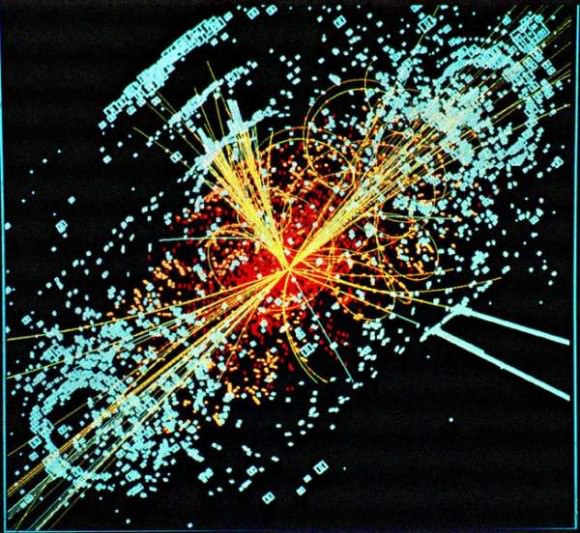
Dark matter is an invisible substance that we cannot detect directly but whose presence is inferred from the rotation of galaxies. Physicists believe that it makes up about a quarter of the mass of the Universe whilst the ordinary and visible matter only makes up about 5% of the mass of the Universe. Its composition is a mystery, leading to intriguing possibilities of hitherto undiscovered physics.
Professor Geoff Hall from the Department of Physics at Imperial College London, who works on the CMS experiment, said, “We have made an important step forward in the hunt for dark matter, although no discovery has yet been made. These results have come faster than we expected because the LHC and CMS ran better last year than we dared hope and we are now very optimistic about the prospects of pinning down Supersymmetry in the next few years.”
The energy released in proton-proton collisions in CMS manifests itself as particles that fly away in all directions. Most collisions produce known particles but, on rare occasions, new ones may be produced, including those predicted by SUSY – known as supersymmetric particles, or ‘sparticles’. The lightest sparticle is a natural candidate for dark matter as it is stable and CMS would only ‘see’ these objects through an absence of their signal in the detector, leading to an imbalance of energy and momentum.
In order to search for sparticles, CMS looks for collisions that produce two or more high-energy ‘jets’ (bunches of particles traveling in approximately the same direction) and significant missing energy.
Dr. Oliver Buchmueller, also from the Department of Physics at Imperial College London, but who is based at CERN, said, “We need a good understanding of the ordinary collisions so that we can recognise the unusual ones when they happen. Such collisions are rare but can be produced by known physics. We examined some 3 trillion proton-proton collisions and found 13 ‘SUSY-like’ ones, around the number that we expected. Although no evidence for sparticles was found, this measurement narrows down the area for the search for dark matter significantly.”
The physicists are now looking forward to the 2011 run of the LHC and CMS, which is expected to bring in data that could confirm Supersymmetry as an explanation for dark matter.
The CMS experiment is one of two general purpose experiments designed to collect data from the LHC, along with ATLAS (A Toroidal LHC ApparatuS). Imperial’s High Energy Physics Group has played a major role in the design and construction of CMS and now many of the members are working on the mission to find new particles, including the elusive Higgs boson particle (if it exists), and solve some of the mysteries of nature, such as where mass comes from, why there is no anti-matter in our Universe and whether there are more than three spatial dimensions.
Red Dwarf Discovery Changes Everything!
[/caption]
Its often said that the number of grains of sand on Earth equals the number of stars in the Universe. Well it looks like a recent study by astronomers working at the Keck Observatory in Hawaii have found that its more like three times the number of grains of sand on Earth! Working with some of the most sophisticated equipment available, astronomers from Yale University have been counting the number of dim red dwarf stars in nearby galaxies which has led to a dramatic rethink of the number of stars in the Universe.
Red dwarfs are small, faint stars compared to most others and until now, have not been detected in nearby galaxies. Pieter van Dokkum and his team from Yale University studied eight massive elliptical galaxies between 50 and 300 million lights years from us and discovered that these tiny stars are much more bountiful than first thought. “No one knew how many of these stars there were,” said Van Dokkum. “Different theoretical models predicted a wide range of possibilities, so this answers a long standing question about just how abundant these stars are.”
For years astronomers have assumed that the number of red dwarfs in any galaxy was in the same proportion that we find here in the Milky Way but surprisingly the study revealed there are about 20 times more in the target galaxies. According to Charlie Conroy of the Harvard-Smithsonian Center who also worked on the project, “not only does this affect our understanding of the number of stars in the Universe but the discovery could have a major impact on our understanding of galaxy formation and evolution.” Knowing that there are now more stars than previously thought, this lowers the amount of dark matter (a mysterious substance that cannot be directly observed but its presence inferred from its gravitational influence) needed to explain the observed gravitational influence on surrounding space.
Not only has the discovery affected the amount of dark matter we expect to find but it also changes the quantity of planets that may exist in the Universe. Planets have recently been discovered orbiting around other red dwarf stars such as the system orbiting around Gliese 581, one which may harbour life. Now that we know there are a significantly higher number of red dwarfs in the Universe, the potential number of planets in the Universe has increased too. Van Dookum explains “There are possibly trillions of Earth’s orbiting these stars, since the red dwarfs they have discovered are typically more than 10 billion years old, so have been around long enough for complex life to evolve, its one reason why people are interested in this type of star.”
It seems then that this discovery, which on the face of it seems quite humdrum, actually has far reaching consequences that not only affect our view of the number of stars in the Universe but has dramatically changed our understanding of the distribution of matter in the Universe and the number of planets that may harbour intelligent life.
The new findings appear in the Dec. 1st online issue of the journal Nature.
Source: from the Harvard Smithsonian Center for Astrophysics.
Mark Thompson is a writer and the astronomy presenter on the BBC One Show. See his website, The People’s Astronomer, and you can follow him on Twitter, @PeoplesAstro
Missing Milky Way Dark Matter
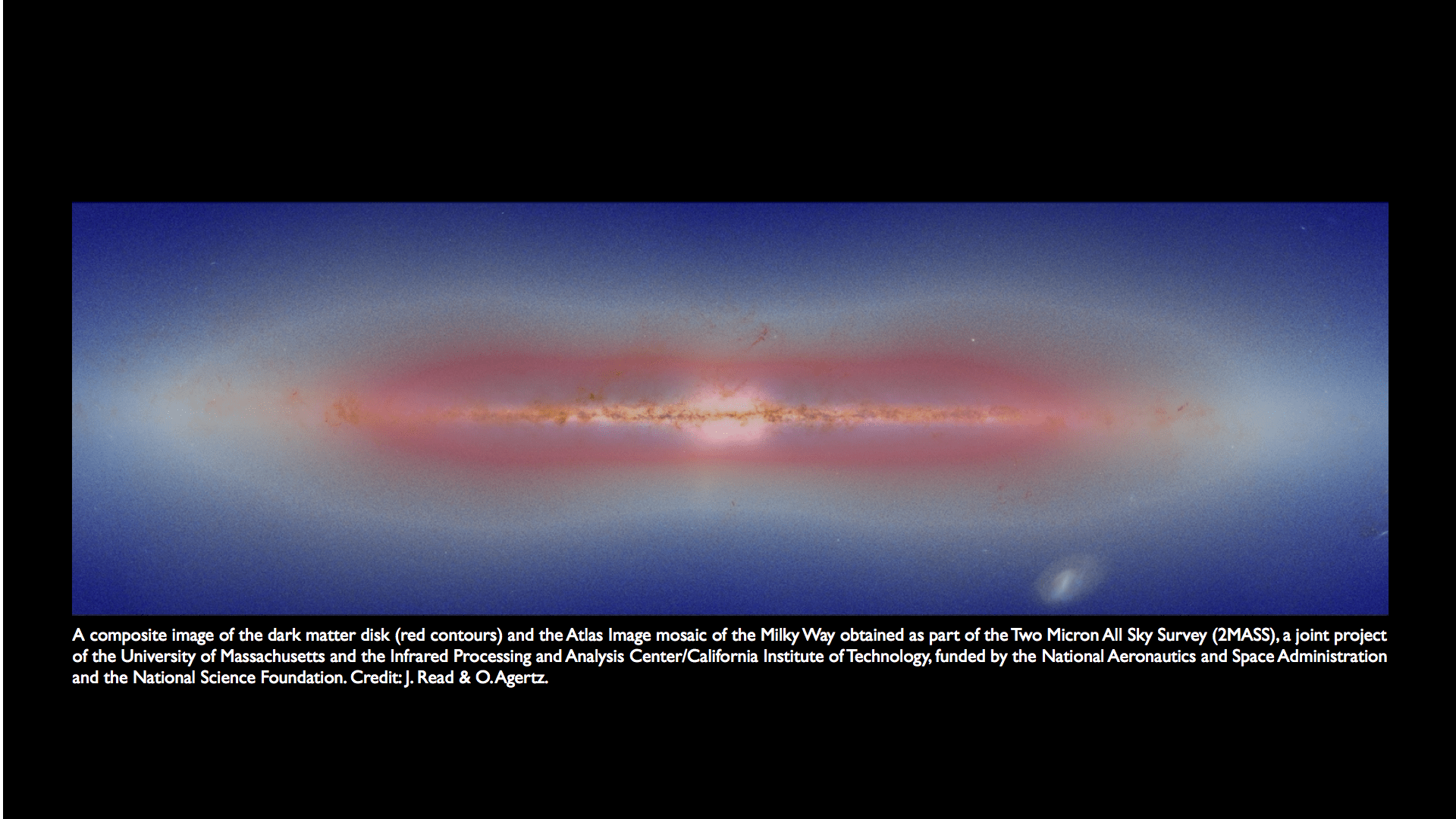
[/caption]
Although dark matter is inherently difficult to observe, an understanding of its properties (even if not its nature) allows astronomers to predict where its effects should be felt. The current understanding is that dark matter helped form the first galaxies by providing gravitational scaffolding in the early universe. These galaxies were small and collapsed to form the larger galaxies we see today. As galaxies grew large enough to shred incoming satellites and their dark matter, much of the dark matter should have been deposited in a flat structure in spiral galaxies which would allow such galaxies to form dark components similar to the disk and halo. However, a new study aimed at detecting the Milky Way’s dark disk have come up empty.
The study concentrated on detecting the dark matter by studying the luminous matter embedded in it in much the same way dark matter was originally discovered. By studying the kinematics of the matter, it would allow astronomers to determine the overall mass present that would dictate the movement. That observed mass could then be compared to the amount of mass predicted of both baryonic matter as well as the dark matter component.
The team, led by C. Moni Bidin used ~300 red giant stars in the Milky Way’s thick disk to map the mass distribution of the region. To eliminate any contamination from the thin disc component, the team limited their selections to stars over 2 kiloparsecs from the galactic midplane and velocities characteristic of such stars to avoid contamination from halo stars. Once stars were selected, the team analyzed the overall velocity of the stars as a function of distance from the galactic center which would give an understanding of the mass interior to their orbits.
Using estimations on the mass from the visible stars and the interstellar medium, the team compared this visible mass to the solution for mass from the observations of the kinematics to search for a discrepancy indicative of dark matter. When the comparison was made, the team discovered that, “[t]he agreement between the visible mass and our dynamical solution is striking, and there is no need to invoke any dark component.”
While this finding doesn’t rule out the presence of dark matter, it does place constraints on it distribution and, if confirmed in other galaxies, may challenge the understanding of how dark matter serves to form galaxies. If dark matter is still present, this study has demonstrated that it is more diffuse than previously recognized or perhaps the disc component is flatter than previously expected and limited to the thin disc. Further observations and modeling will undoubtedly be necessary.
Yet while the research may show a lack of our understanding of dark matter, the team also notes that it is even more devastating for dark matter’s largest rival. While dark matter may yet hide within the error bars in this study, the findings directly contradict the predictions of Modified Newtonian Dynamics (MOND). This hypothesis predicts the apparent gain of mass due to a scaling effect on gravity itself and would have required that the supposed mass at the scales observed be 60% higher than indicated by this study. Continue reading “Missing Milky Way Dark Matter”



